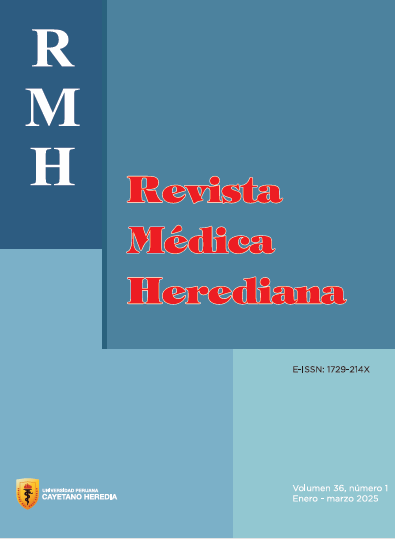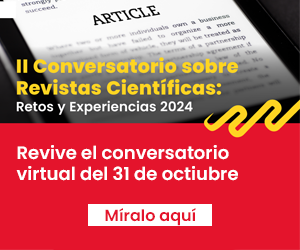Morbimortalidad en pacientes sometidos a cirugía de bypass coronario, operados con y sin infarto de miocardio agudo
DOI:
https://doi.org/10.20453/rmh.v36i2.5338Palabras clave:
Puente de arteria coronaria, infarto del miocardio, enfermedad de la arteria coronariaResumen
Objetivo: Comparar la morbimortalidad de los pacientes sometidos a cirugía de bypass coronario con infarto miocárdico agudo (IMA) y electivamente (NO IMA). Material y métodos: Estudio de cohorte retrospectivo. Se revisaron las historias clínicas de 237 pacientes operados de bypass coronario por enfermedad coronaria de 3 vasos y tronco izquierdo (3V/TI). Se identificaron 63 pacientes operados con infarto agudo de miocardio (IMA) y 174 electivamente sin IMA (NO IMA). Se comparó la morbimortalidad en el periodo hospitalario o 30 días post operatorios. Resultados: Las características clínicas fueron similares en ambos grupos. Se encontró en el grupo IMA mayor mortalidad operatoria (IMA 7,94% vs. NO IMA 1,15%) (p=0,006). Las complicaciones post operatorias más frecuentes en pacientes operados en IMA fueron: accidente cerebrovascular 7,94 vs 0,57% (p=0,001), reintervención por sangrado post operatorio 6,35% vs 1,15% (p=0,024) e insuficiencia renal aguda 15,2% vs 3,5% (p=0,009). Conclusiones: Los pacientes con enfermedad de 3V/TI que fueron tratados con cirugía de Bypass Coronario en IMA tuvieron con mayor frecuencia complicaciones post operatorias neurológicas, reintervención postoperatoria por sangrado, injuria renal aguda transitoria y mayor mortalidad que los pacientes que se operaron electivamente.
Descargas
Citas
Organización Mundial de la Salud (OMS). Las 10 principales causas de defunción [Internet]. 2020 [citado 1 de septiembre de 2023]. Disponible en: https://www.who.int/es/news-room/fact-sheets/detail/the-top-10-causes-of-death
Reyes, M. Vlásica, J. Registro Nacional de Infarto al Miocardio III (2014). Rev Per Card. 2018; XLIV(2):46-66. Disponible en: https://sopecard.org/revista-sp/2018/Revista-2-2018.pdf
Mensah GA, Wei GS, Sorlie PD, Fine LJ, Rosenberg Y, Kaufmann PG, et al. Decline in Cardiovascular Mortality: Possible Causes and Implications. Circ Res. 2017;120(2):366-80. doi: 10.1161/CIRCRESAHA.116.309115
Murphy ML., Hultgreen HN, Detre K, et al: Treatment of Chronic stable angina: A preliminary report of survival data of the randomized Veterans Administration Cooperative Study. N Engl J Med. 1977; 297:621.
The Veterans Administration Coronary Artery Bypass Surgery Cooperative Study Group, 1984: Eleven-year survival in the Veterans Administration Randomized Trial of Coronary Bypass Surgery for stable angina. N Engl J Med. 1984; 311:1333-1339. doi: 10.1056/NEJM198411223112102.
Yusuf S, Zucker D, Passamani E, Peduzzi P, Takaro T, Fisher LD, et al. Effect of coronary artery bypass graft surgery on survival: overview of 10-year results from randomised trials by the Coronary Artery Bypass Graft Surgery Trialists Collaboration. The Lancet. 1994;344(8922):563-70.
Alderman EL, Bourassa MG, Cohen LS, Davis KB, Kaiser GG, Killip T, et al. Ten-year follow-up of survival and myocardial infarction in the randomized Coronary Artery Surgery Study. Circulation. 1990 Nov;82(5):1629-46. doi: 10.1161/01.cir.82.5.1629.
Thuijs DJFM, Kappetein AP, Serruys PW, Mohr FW, Morice MC, Mack MJ, et al. Percutaneous coronary intervention versus coronary artery bypass grafting in patients with three-vessel or left main coronary artery disease: 10-year follow-up of the multicentre randomized controlled SYNTAX trial. The Lancet. 2019;394(10206):1325-34. doi: http://dx.doi.org/10.1016/ S0140-6736(19)31997-X.
Park SJ, Ahn JM, Kim YH, Park DW, Yun SC, Lee JY, et al. Trial of Everolimus-Eluting Stents or Bypass Surgery for Coronary Disease. N Engl J Med. 2015;372(13):1204-12. doi: 10.1056/NEJMoa1415447.
Fearon WF, Zimmermann FM, De Bruyne B, Piroth Z, Van Straten AHM, Szekely L, et al. Fractional Flow Reserve–Guided PCI as Compared with Coronary Bypass Surgery. N Engl J Med. 2022;386(2):128-37. doi: 10.1056/NEJMoa2112299.
Warren J, Mehran R, Baber U, Xu K, Giacoppo D, Gersh BJ, et al. Incidence and impact of acute kidney injury in patients with acute coronary syndromes treated with coronary artery bypass grafting: Insights from the Harmonizing Outcomes With Revascularization and Stents in Acute Myocardial Infarction (HORIZONS-AMI) and Acute Catheterization and Urgent Intervention Triage Strategy (ACUITY) trials. Am Heart J. 2016;171(1):40-7. doi: 0.1016/j.ahj.2015.07.001.
Hansson EC, Jidéus L, Åberg B, Bjursten H, Dreifaldt M, Holmgren A, et al. Coronary artery bypass grafting-related bleeding complications in patients treated with ticagrelor or clopidogrel: a nationwide study. Eur Heart J. 2016;37(2):189-97. doi: 10.1093/eurheartj/ehv381.
Mao Z, Zhong X, Yin J, Zhao Z, Hu X, Hackett ML. Predictors associated with stroke after coronary artery bypass grafting: A systematic review. J Neurol Sci. 2015;357(1-2):1-7. doi: http://dx.doi.org/10.1016/j.jns.2015.07.006.
Serruys PW, Morice MC, Kappetein AP, Colombo A, Holmes DR, Mack MJ, et al. Percutaneous Coronary Intervention versus Coronary-Artery Bypass Grafting for Severe Coronary Artery Disease. N Engl J Med. 2009;360(10):961-72. doi: 10.1056/NEJMoa0804626.
Åström A, Söderström L, Mooe T. Risk of Ischemic Stroke After Acute Myocardial Infarction in Patients Undergoing Coronary Artery Bypass Graft Surgery. Sci Rep. 2020;10(1):3831. doi: https://doi.org/10.1038/s41598-020-60854-1.
Kandimalla J, Hussain Z, Piriyawat P, Rodriguez G, Maud A, Khatri R, et al. Stroke Rates Following Surgical Versus Percutaneous Revascularization for Ischemic Heart Disease. Curr Cardiol Rep. 2021;23(5):45. doi: 10.1007/s11886-021-01471-w.
Braxton JH, Hammond GL, Letsou GV, Franco KL, Kopf GS, Elefteriades JA, et al. Optimal Timing of Coronary Artery Bypass Graft Surgery After Acute Myocardial Infarction. Circulation. 1995;92(9):66-8. doi: https://doi.org/10.1161/01.CIR.92.9.66.
Bernard C, Morgant MC, Jazayeri A, Perrin T, Malapert G, Jazayeri S, et al. Optimal Timing of Coronary Artery Bypass Grafting in Haemodynamically Stable Patients after Myocardial Infarction. Biomedicines. 2023;11(3):979. doi: https://doi.org/10.3390/ biomedicines11030979.
ElBardissi AW, Aranki SF, Sheng S, O’Brien SM, Greenberg CC, Gammie JS. Trends in isolated coronary artery bypass grafting: An analysis of the Society of Thoracic Surgeons adult cardiac surgery database. J Thorac Cardiovasc Surg. 2012;143(2):273-81. doi: 10.1016/j.jtcvs.2011.10.029.
Schwann TA, Habib RH, Wallace A, Shahian DM, O’Brien S, Jacobs JP, et al. Operative Outcomes of Multiple-Arterial Versus Single-Arterial Coronary Bypass Grafting. Ann Thorac Surg. 2018;105(4):1109-19. doi: https://doi.org/10.1016/j.athoracsur.2017.10.058.
Rojas F. Morbilidad y mortalidad en revascularización miocárdica Hospital Nacional Edgardo Rebagliati Martins. Estudio de 168 casos. Rev Peruana Card. 2003; 29(3):163-171.
Reyes M, Ruiz E. Registro Nacional de Infarto de Miocardio Agudo II. RENIMA II. Rev Peruana Card. 2013;39(1):60-71.
Reyes M, Heredia J, Campodónico S, Drago J, Alvarado O. Registro nacional de infarto miocárdico agudo (RENIMA). Rev Peruana Card. 2008; 34(2):84-98.
Descargas
Publicado
Cómo citar
Número
Sección
Licencia
Derechos de autor 2025 Oscar Talledo Quaglino, Adriana Gutierrez Yllu

Esta obra está bajo una licencia internacional Creative Commons Atribución 4.0.
Los autores ceden sus derechos a la RMH para que esta divulgue el artículo a través de los medios que disponga. Los autores mantienen el derecho a compartir, copiar, distribuir, ejecutar y comunicar públicamente su artículo, o parte de él, mencionando la publicación original en la revista.


















